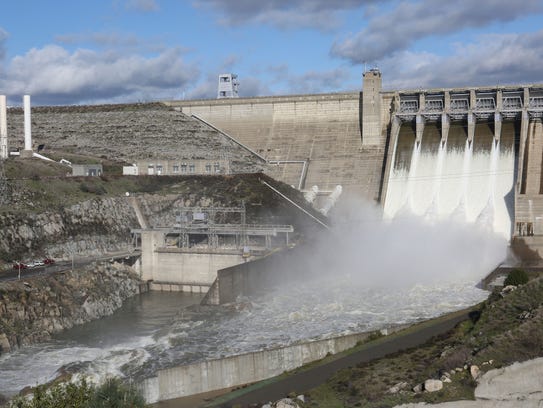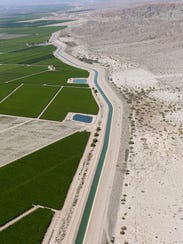
Between 2011 and 2014, during the height of the drought, electricity production from hydropower dropped more than 60 percent as rivers dried up and reservoir levels fell, according to a new study led by researchers at the University of California, Irvine. That low-carbon electricity was replaced largely by natural gas, which generates climate pollution. The result: From 2012 through 2014, the state's electricity sector generated 33 percent more carbon dioxide annually than it had in 2011, scientists found.
"If you look at just the California drought, the amount of additional (carbon dioxide) in the atmosphere is probably not a lot. But droughts happen everywhere, all the time, throughout the world," said Amir AghaKouchak, a UC Irvine engineering professor and co-author of the study. "So we argue that the cumulative effects of these extreme events like droughts and heat waves are significant."
In other words: As climate change makes droughts worse, those droughts could make climate change worse as well, creating a vicious cycle.
Hydropower down, climate pollution up during drought...
Electricity production from hydropower plants declined during the height of the California drought, as rivers dried up and reservoir levels fell. That climate-friendly electricity was replaced largely by natural gas plants, leading to an increase in planet-warming carbon dioxide emissions.
The new study, published this month in the journal Sustainable Cities and Society, builds on a similar report from the Pacific Institute, an Oakland-based water think tank. The Pacific Institute's latest update to that report, published earlier this year, estimated the drought had forced Californians to pay $2 billion in additional electricity costs from late 2011 through late 2015, since natural gas is more expensive than hydropower. The nonprofit group also calculated estimates for the decrease in hydropower production and the increase in carbon emissions.
Peter Gleick, the Pacific Institute's president emeritus and author of its drought-hydropower report, said there are a few differences between the new study and his previous work. For one thing, the UC Irvine study is peer-reviewed. Its authors also calculated how much clean energy California would have needed to avoid a big increase in climate pollution. They found that if the Golden State had built new solar and wind power roughly two and a half times as fast as it actually did from 2012 through 2014, the drop in hydropower wouldn't have necessitated much new natural gas.
The researchers ran one other calculation, asking whether urban areas could have significantly boosted hydropower by saving water, thereby leaving more of the stuff behind dams. What would have happened if California cities had slashed water use by 25 percent, the target later mandated by Gov. Jerry Brown, from 2012 through 2014?
If all of that saved water had contributed to hydropower, there would have been an 18 percent bump in production, relative to what was actually seen during the drought. That increase would have shaved 5.7 million metric tons of carbon dioxide from the state's climate footprint, researchers found — just a quarter of the 21.9 million metric tons of additional emissions due to the drought.

Water rushes out of Folsom Dam in Folsom, California, near Sacramento, on Dec. 16, 2016. The dam produced just 397 million kilowatt-hours of electricity in 2013, according to the U.S. Bureau of Reclamation — down from 775 million kilowatt-hours in 2011. (Photo: Jay Calderon/The Desert Sun)
The hard reality, AghaKouchak said, is that urban water savings alone wouldn't have been enough. Agriculture is responsible for about 80 percent of human water use in California.
"Using less domestic water is not necessarily going to change available water for hydro by much," AghaKouchak said. "But if you include other aspects (like farming) and go for more aggressive conservation, then obviously there will be more water available for hydro."
READ MORE: Farm water use comes under scrutiny
Brown has faced criticism for ordering cities but not farms to reduce their water use, even though many farms still use inefficient flood irrigation. State water managers and agricultural interests say the industry has been getting more efficient and that many farms have been forced to cut back anyway because the state and federal governments are sending them less water.
"The lack of attention to agriculture is a huge problem," Jay Famiglietti, a hydrologist and senior water scientist at NASA's Jet Propulsion Laboratory, told The Desert Sun in 2015. "The number one thing that we have to do is to work with agriculture, and that may mean imposing restrictions on agriculture to become more efficient. Yes, they're making tremendous progress, but much more progress can be made."

The Coachella Canal, a branch of the All-American Canal that carries Colorado River water to desert farms, runs through the eastern Coachella Valley on April 15, 2015. (Photo: Jay Calderon/The Desert Sun)
Meanwhile, Brown's State Water Resources Control Board ended mandatory water conservation for cities earlier this year, allowing urban water agencies to set their own targets. Using a formula developed by the state, many agencies set zero percent targets, including the Coachella Valley Water District and the Desert Water Agency. Since then, water conservation has declined statewide.
In November, state water managers said they may implement a stricter formula to determine urban cutback targets, as part of a long-term plan to "make conservation a California way of life."
Californians may not face immediate consequences if the state keeps backsliding on water savings. While anything could happen over the next few months, reservoir levels are up across the state after a wet December. Forty-two percent of the state is still suffering from extreme or exceptional drought, but 30 percent is no longer experiencing drought — up from 3 percent a year ago.
Gleick, the Pacific Institute scientist, said it looks like California will have an average water year.
"At the moment, that looks like it'll be the end of the drought," he said. "At least temporarily."
Sammy Roth writes about energy and the environment for The Desert Sun. He can be reached at [email protected], (760) 778-4622 and @Sammy_Roth.
source: http://www.desertsun.com/
original story HERE
To help do something about the climate change and global warming emergency, click here.
Sign up for our free Global Warming Blog by clicking here. (In your email, you will receive critical news, research, and the warning signs for the next global warming disaster.)
To share this blog post: Go to the Share button to the left below.

Be the first to comment
Sign in with